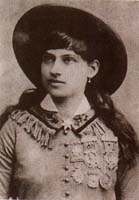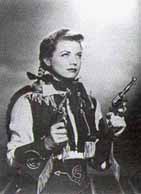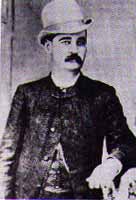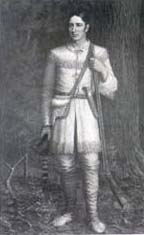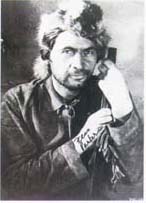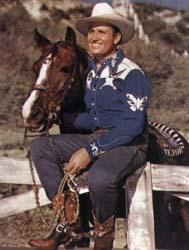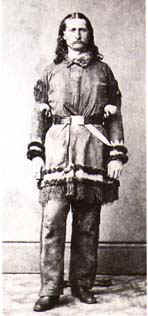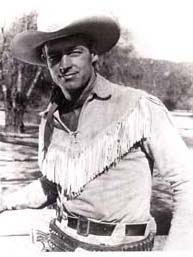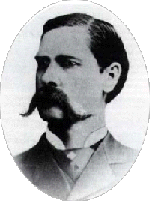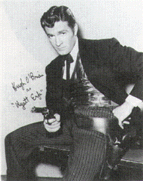Here are some excepts from this educational and colorful book highlighting some of the most famous Real West and TV Western characters.
| Annie Oakley | ||
|
Long before the feminists were taking aim at us male chauvinists, Gail Davis, that beautiful, pig tailed blonde, was showing us that women were just as clever at handling law and order, shooting and riding along with the best of her male counterparts. Annie Oakley rode into our living rooms from April 1953 through December 1956 covering 81 episodes on ABC. Gail Davis will best be remembered for bringing Annie Oakley into our living rooms in one of TV’s earliest westerns. |
|
| Bat Masterson | ||
|
This TV western program was based on the real western lawman whose full name was William Barclay Masterson. Some say he was one of the toughest lawmen that ever graced the wild west. Some say he was one of the most clever and shrewd. "Bat" Masterson, much to the dismay of critics who lump all westerns as "violent", would never use his gun when he could use his brains or his "bat" instead. In fact, as we shall see later, he earned his nickname as he patrolled Dodge City’s Front Street at night with his cane, and instead of firing bullets, he cracked heads when cowhands and malcontents tested his nerve. | 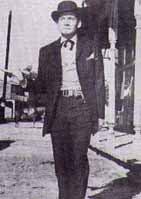 Gene Barry, TV's Bat Masterson |
| Davy Crockett | ||
|
To do "the King of the Wild Frontier" proper justice, you'd need to do two books--one on Davy Crockett himself, and one on the popularity of Walt Disney's Davy Crockett starring Fess Parker. Crockett was a real American frontiersman who became a legend in his own time and a bigger one after his death at the Alamo. But it was Walt Disney, always in his efforts to give American youngsters real life heroes to imitate and emulate, that made Davy Crocket a household word in 1954. There is little debate that Davy Crockett became an American phenomenon in the mid-1950s. |
|
| Gene Autry | ||
|
America’s "Singing Cowboy" started off as a choir singer and although a Texan by birth, his family moved to Oklahoma where he grew up and initially got billing as "Oklahoma’s Yodeling Cowboy". From those humble beginnings, Gene Autry, born in 1907, went on to become of the "Big 3 favorites" along with Hopalong Cassidy and Roy Rogers. Just about everyone I have met in this wonderful hobby started off and some still collect one of the "Big 3." Thus, the great and early popularity of Gene Autry goes back to cart iron guns, as does Roy Rogers, a point not shared by Hoppy even though he, too, started his career long before the TV westerns. | |
| Gunsmoke | ||
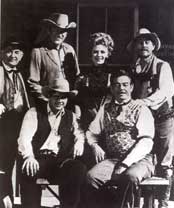 |
Set
in Dodge City, Kansas, during the 1870s, Gunsmoke, came to television on
September 10, 1955, and changed the course of TV westerns for all
time. Gunsmoke, rarely out of the Top 10, has the unbeaten
distinction of having been the longest-running, uninterrupted television
show in history.
Initially it started slowly, going up against the already established George Gobel Show on Saturday nights, and in the first season, it didn't even make it to TV's Top 15. The following season, however, it shot to No. 8. From 1957 to 1962, it was the top-rated program in all television. Even as more than 30 westerns dominated television, Gunsmoke continued to lead the pack. It lasted 20 years, longer than any program ever, with continuing characters and new characters. |
|
| Have Gun Will Travel | ||
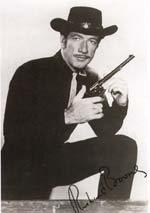 |
Clearly, one of television’s finest westerns and one of the most popular was "Have Gun-Will Travel" starring Richard Boone as Paladin. It remains one of my personal favorites and judging by the amount of collectors that are addicted to "Paladin" memorabilia, I’m not alone. Today, even the videos of the "Have Gun-Will Travel" program are on the top of the western buff’s list, and anyone who remembers the show can easily understand why. | |
| Hopalong Cassidy | ||
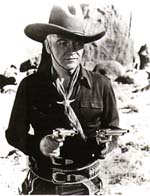 |
The most popular, most adored, indeed revered, as well as the most marketed cowboy that ever "lived" was America’s beloved Hopalong Cassidy. Here was and is a cowboy that grandfather, father, son and grandson remember, love, and know about still. That’s true even if today’s fourth generation never enjoyed "Hoppy" the way we did, most have heard of him from Dad or Grandpa. There are two excellent books on Hopalong Cassidy from the collector’s perspective, so my main focus here is the background of this wonderful character, the fans that continue to idolize him and the cap guns that we search out and collect with seemingly unabated fervor. | |
| John Wayne - The Duke | ||
 |
The
"Duke" of western stars in film history was none other than John
Wayne. A man of imposing size and screen presence, John Wayne seemed
to embody what the American cowboy was all about. Tall, handsome,
rugged, yet somewhat soft-spoken and slow to anger, he portrayed his
western characters with ideals, romance and a certain screen nobility.
Born in 1907 in Iowa, his real name was Marion Michael Morrison. Beginning as a prop man in 1928, he landed his first role in The Big Trail in 1930. He was just fresh out of University of Southern California, which he had attended on a football scholarship, when John Ford recommended him to director Raoul Walsh for The Big Trail, a film epic being shot in 70mm. This was followed by a string of "B" westerns. It wasn't until 1938, when he was cast as The Ringo Kid in Stagecoach that John Wayne found stardom, doing his own action sequences and handling sensitive love scenes opposite Claire Trevor. |
|
| The Lone Ranger | ||
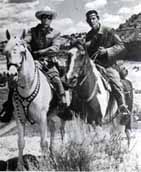 |
Who was that masked man ?". The Lone Ranger, of course! One of America’s most beloved fictional western heroes, The Lone Ranger came to life, ironically, after cheating death, in 1933. Working with a young writer named Fran Striker, Detroit radio owner George Trendle created the new "champion of justice" based loosely, it was said at the time, on some real life exploits the Texas Rangers in the 1870's. Hoping to appeal to adults as well as children, this strange character, wearing a mask - the main tool of bandits and thieves to hide their identity - was first broadcast from Radio Station WXYZ in Detroit on February 2, 1933. The Lone Ranger has never left our hearts, our imagination or our memories. | |
| Rebel - Johnny Yuma | ||
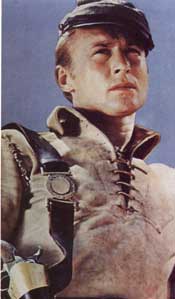 |
"Johnny Yuma" was a bitter, battled-hardened ex-Confederate soldier, hence the title The Rebel. Set in the 1860s, following his Civil War service, Yuma heads west, trying to carve out a new life for himself, knowing that the South he loved, for the most part, was gone. He was a young man of strong ethics and principles. As he searches for his own identity and a renewed sense of self-worth after losing everything in the war, he brings his anger, intensity, and rebel attitude along with him as he goes from town to town further westward. | |
| Roy Rogers | ||
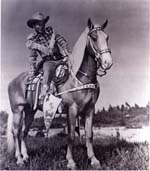 |
He was, and is "The King of the Cowboys". His wife on and off screen was and is, "The Queen of The West". With the soft and warm theme song "Happy Trails To You", Roy Rogers, one of America’s most beloved and respected western stars, came to our television screens on December 30, 1951. Along with Hopalong Cassidy, Gene Autry, and The Lone Ranger, Roy was among this foursome to win his own place in the hearts and minds of millions of youngsters and adults in the early 1950's and continues to be there today. | |
| Wild Bill Hickok | ||
|
If there is one thing I’ve learned about the Old West, it’s the fact that there is no other area of general historical interest that has had more than its share of romantic and controversial characters. Few would question that Wild Bill Hickok was a legend even in his own time. Historians by the dozens in the 1940's and 1950's added to this legend, with articles, books, interviews, additional evidence and photos on this feared lawman-gunfighter. Certainly, Hollywood took notice, since movies and television programs that featured Wild Bill Hickok and his "legend" abound, just as they did about Wyatt Earp, Hickok’s closest match. |
|
| Wyatt Earp | ||
|
The man who epitomizes all that the "Wild West" stood for, probably America’s most admired, talked about, debated over and recognized lawman was Wyatt Earp. He has withstood the test of time. More than a dozen biographies, conspiracies, documentaries, countless movies and televi- sion programs about him, his life, his times, his legends, his gunfight at the O.K. Corral, and the impact he left on Tombstone continue to this day. Wyatt Earp outlived his contemporaries - Bat Masterson, Wild Bill Hickok, Pat Garrett, Texas John Slaughter, Bill Tilghman, even all of the Earp brothers, four of whom were lawmen themselves. He continues to represent the American frontier marshal, a man of courage and tenacity against the lawless element of the Old West.
|
|
| Zorro | ||
 |
And this brings a smile to your lips, as you fondly recall the memories of your youth, sitting down every Thursday evening, from 8:00 to 8:30 PM as you watch your masked and caped hero on his thundering black stallion, "Tornado", crusade against injustice in old California. Zorro wears a mask, but more importantly, he leaves a special mark to serve as a reminder that he will return every time power and tyranny reign against the poor people, the innocent people and the hard working peasants in 1820's California. He leaves a "Z", which stands for his name - Zorro! |
|
These and 76 other characters are all heavily illustrated in this voluminous book with pages and pages of color photographs showing all the cap guns, holster sets and cap rifles honoring these western heroes.
